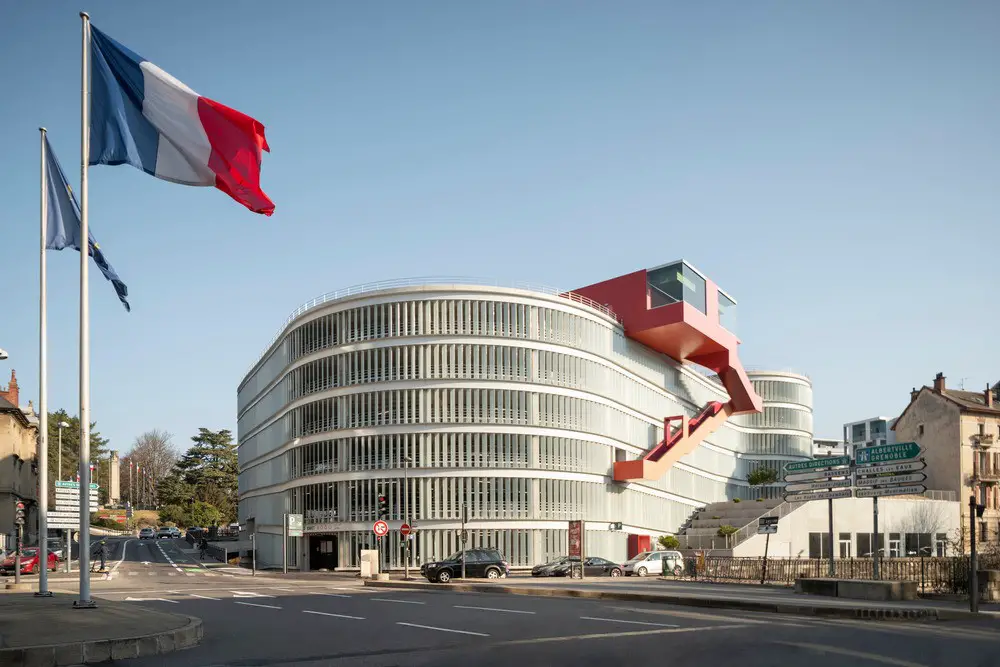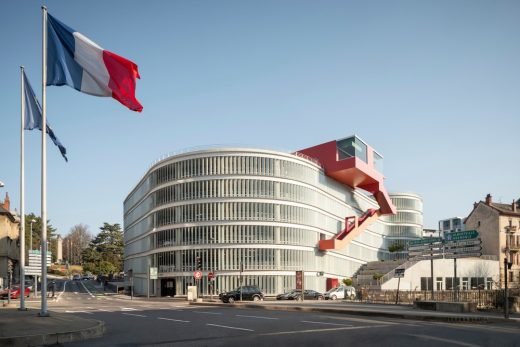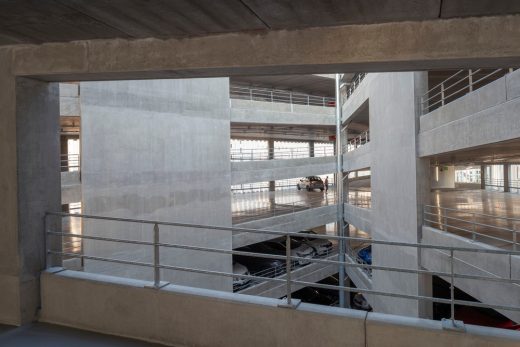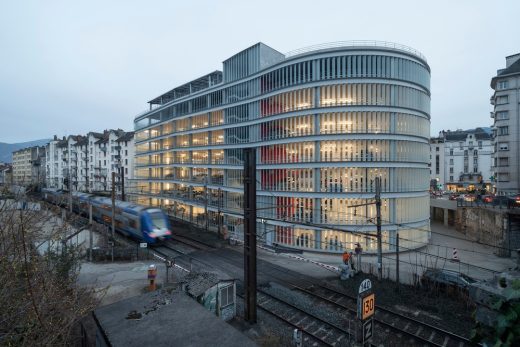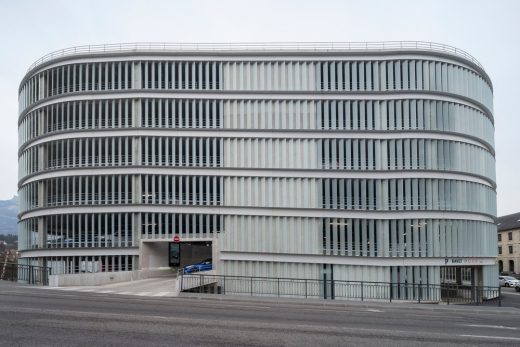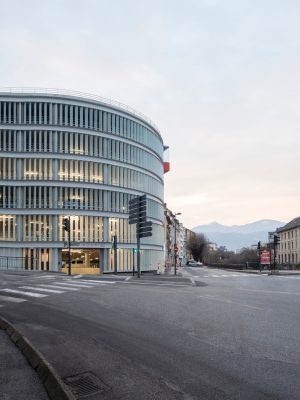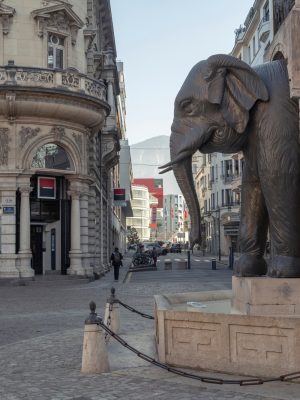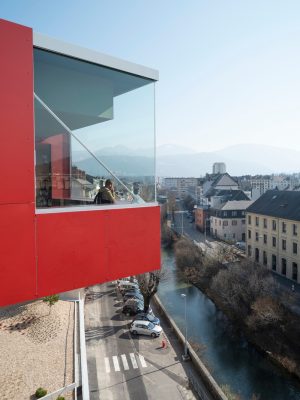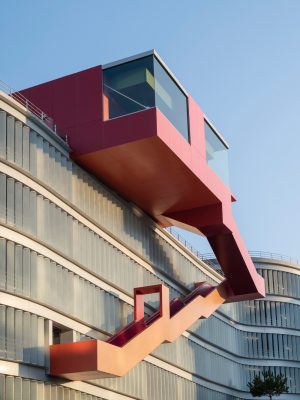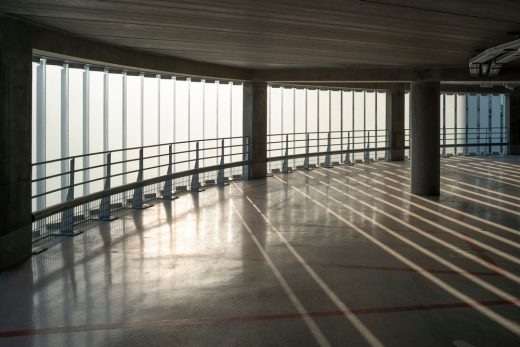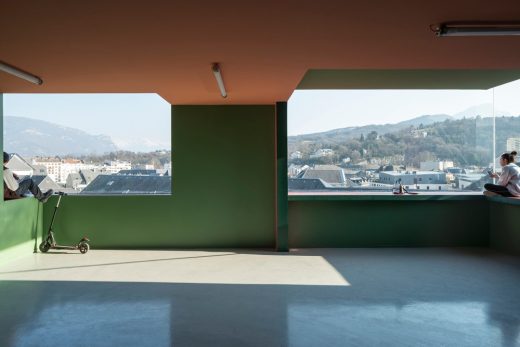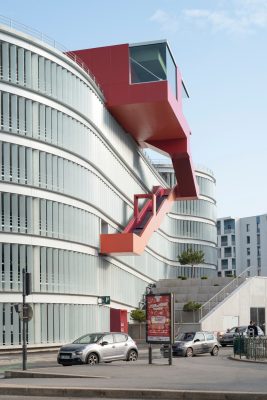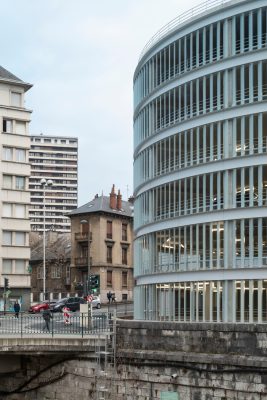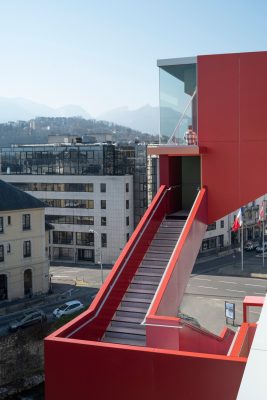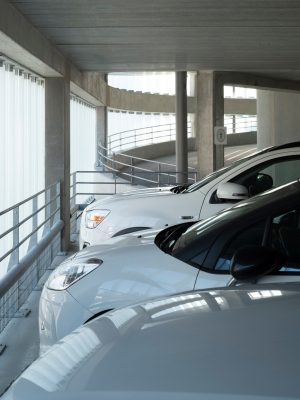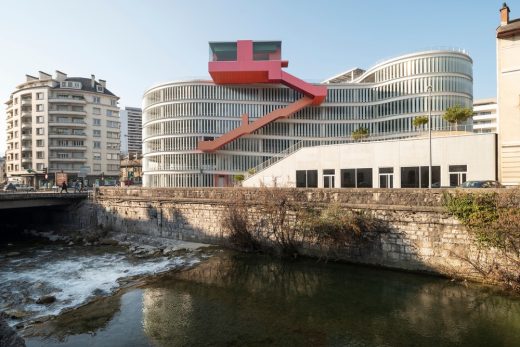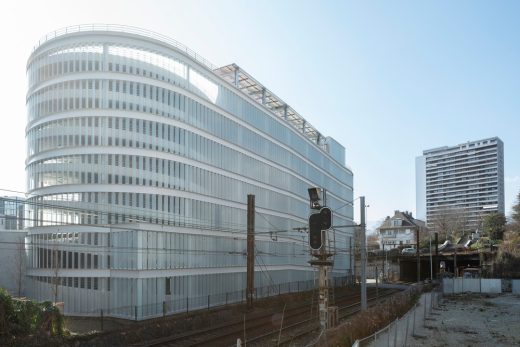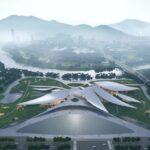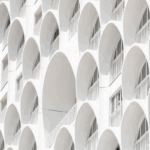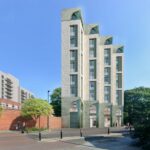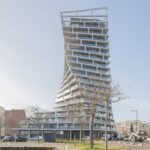Q-Park Ravet, Chambéry Parking House, French Car Park Building Development, France Architecture Images
Q-Park Ravet, Chambéry, France
25 Jan 2023
Design: Hérault Arnod
Location: Chambéry, Savoie department, Auvergne-Rhône-Alpes region, southeastern France
Photos by Cyrille Weiner
Q-Park Ravet, France
Designed for QPark by Hérault Arnod architectes, in collaboration with artist Krijn de Koning, Ravet is a new 499-space car park with a curved and translucent volume. The structure is located on the edge of the historic district and provides users with a panoramic view of the city of Chambéry and the mountains beyond.
Sculptural architecture
The land chosen by the City for construction of the car park construction is located along rue de Boigne, a historic road in the Chambéry city center. The street, built in the first half of the 19th century and lined with arcades, leads to the castle of the Dukes of Savoy, a major heritage building built in the 12th century, passing by the famous Elephant Fountain. Opposite the castle, the perspective of the street converges on the Q-Park Ravet project, with a backdrop of mountains.
The question pondered by the architects was how to build a car park, considered utilitarian, facing the city’s most historic monument. That question was met with a unique architectural response in the form of a proposition to, in addition to the program, create a sculptural belvedere located in the axis of the street and the castle, imagined in collaboration with artist Krijn de Koning.
The car park, curved and translucent
The car park is organized in a triangle, with rounded corners that minimize the mass effect and create sleek and vanishing lines that make the building appear smaller than it actually is. The interior space is designed like a car ride organized around a double circuit: you go up via slightly sloping lots that wrap around a central triangular patio; you descend directly via a cylindrical ramp around a central void.
The building is a translucent and light volume that blends smoothly into the urban fabric, with curves at the ends of the triangle corresponding with those of the rounded corners of the neighboring buildings. The facades are 50% empty, so the car park is considered exempt from fire regulations, and they are clad in vertical glass strips placed at 45° (60% recycled glass and enameled to be opalescent). The empty gaps create a variety of additional views of the city.
The exterior of the building consists of a U-shaped metal profile that wraps around the building from street level to the top floor. Between these metallic U-shaped sections, the glass strips mask the interior in a show-and-tell pattern that can be seen from both inside and outside the garage. By day, the functionality of the building is on full display. By night, perceptions changes thanks to indoor lighting that softly etches the urban landscape.
Located on the car park rooftop, shading structures equipped with photovoltaic cells shelter the cars.
The interior of the triangular patio is a garden of shadows, planted with undergrowth vegetation – ferns, periwinkles, maples, hydrangeas, and more. The facing south terrace features Mediterranean-type vegetation with umbrella pines, fig trees, lavender, and grasses.
The belvedere, orthogonal and colorful
The strategic position of the project at the end of the main historical city street led to the design of an architectural solution that offers something more to both residents and visitors, adding another function to the parking project. The belvedere lends a public and urban dimension to the building, enabling a new way to embrace the city.
Via an external staircase, the belvedere can be accessed from the second floor without going through the parking garage. The belvedere-sculpture, cantilevered out to the axis of the rue de Boigne, is attached to the building of the car park, with tones subduing the warm colors of the old town houses facades. From above, it offers a majestic panorama towards the urban landscape, the river, the castle, and the Alps. Descending the belvedere staircase puts you on the axis of the street, and it is framed at mid-height to highlight a unique perspective of the historic city.
In the other direction, the street perspective ends with the mountain background and the curved, translucent volumes combination of the car park and the sculptural belvedere that leans against it in the axis of the city street.
The architectural gesture is based on the complementarity between the curved, minimal, and translucent car park facades, and the sculptural sky bar, orthogonal and colored. This assembly of the car park and the belvedere gives the building its unique identity. It was in line with this idea that the collaboration with Krijn de Koning was established.
Q-Park Ravet in Chambéry, France – Building design
Design: Hérault Arnod – https://www.herault-arnod.fr/
Site: Quai Chambéry – France
Project owner: QPark
Project management
– Hérault Arnod Architectures, Lead Architect
Thomas Féraud, Jérôme Moenne-Loccoz and Florent Bellet, Project Managers
– Krijn de Koning, Artist
– Art Entreprise, Georges Verney-Carron, Artistic Development
– Arcadis, Structural Design, Fluid Engineering and Roadworks & Utilities
Type of mission: Comprehensive project management and partial execution
Floor area: 14,500 sqm
Cost of the works: €10 M excl. VAT
Program
Silo car park with 499 spaces
Belvedere / Skybar
Schedule: Competition November 2016
Delivery 2021: General contractor
Chanut
Main subcontractors
Blanchet: locksmithing and carpentry.
Miroiterie de chartreuse: glazed facades,
Noir étanche & Etandex: waterproofing
Gillet, HVAC Rhoniselec, electricity
Garden, planting
Krijn de Koning
About Krijn de Koning
Krijn de Koning was born in the Netherlands in 1963, and he currently lives and works in Amsterdam. He was trained at the Rietveld Academy before passing through the Ateliers, then the Institut des Hautes Études en Art Plastique in Paris in the early 1990s, where he held his first exhibitions at that time. Since then, Krijn de Koning has been developing a reflection that primarily takes the form of in-situ work. The locations of his ephemeral or permanent interventions range from museum or institutional spaces to public spaces; from heritage sites (castles, churches) to industrial sites, from art galleries to private spaces.
Between architecture and sculpture, his works provide an impetus for a reinterpretation of the place for which they are conceived. The spectator is enticed to go through and experiment the structures he conceives, most of which integrate walls, floors, openings (windows and doors), stairs, and more. Colour acts as a reading tool for lending greater simplicity or complexity to the space, converting structures into objects vacillating between the architectural and the sculptural, depending on the scale of the project and its place in a given space.
Hérault Arnod Architectures
About Hérault Arnod Architectures
Hérault Arnod architectures is a Parisian architectural firm founded in the early 1990’s in Grenoble by Yves Arnod and Isabel Hérault. The team is composed of fifteen architects with different profiles and nationalities who share a demanding and prospective vision of architecture.
The studio develops diverse programs, from micro to macro, from small architectural objects to territorial scale projects, for both private and public clients. The studio escapes from the idea of programmatic specialization and designs projects for working spaces, concert and theatre halls, sport and cultural facilities, housing, mixed-use buildings, and more.
With every project, the will to escape ready-made solutions or the transposition of recipes implies a research process offering pertinent and original solutions that draw their substance from the specificity of the milieu where the project is implanted. The architecture seeks to reveal existing forces and energies, with the goal of always finding the right solution to a given situation. This method, starting from context studies, produces very diverse buildings; the recurrence is in the process rather than the formal result.
Photos: Cyrille Weiner
Parking building designs / Car building designs
Q-Park Ravet, Chambéry, France images / information received 250123 from v2com newswire
Location: Chambéry, France, western Europe
New Southeast France Buildings
Southeast French Architectural Projects
Mountain House II, Auvergne-Rhône-Alpes, southeast France
Design: studio razavi architecture
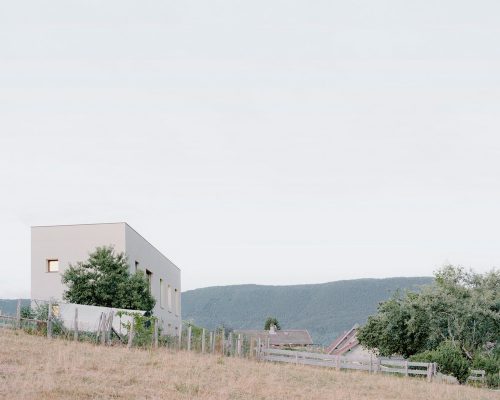
photo © Simone Bossi Photographer
Mountain House II Auvergne-Rhône-Alpes
Université de Provence à Aix-en-Provence – Nature instead of Technology
Design: Dietmar Feichtinger Architectes
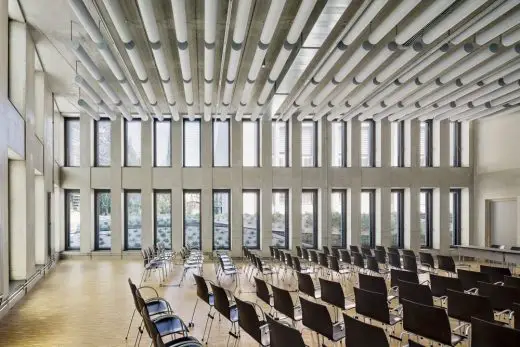
photograph : Sergio Grazia
Université de Provence à Aix-en-Provence
New Buildings in France
French Architectural Projects
Another spectacular Alps Building on e-architect:
“Hut of the Future”
Design: ETH Zurich and the Swiss Alpine Club (SAC)
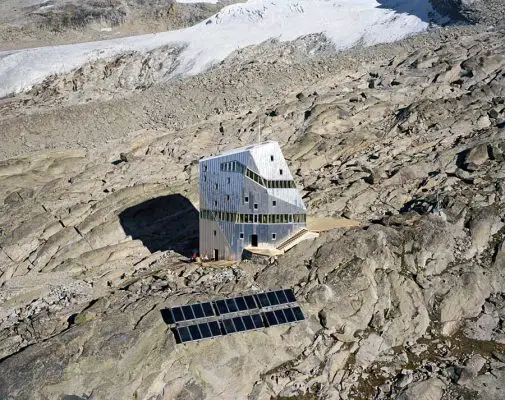
photo : ETH-Studio Monte Rosa/Tonatiuh Ambrosetti
Neue Monte Rosa Hut
More French Alps buildings on e-architect:
Chalet Dag, Chamonix-Mont-Blanc, Haute-Savoie, southeast France
Design: Chevallier Architectes
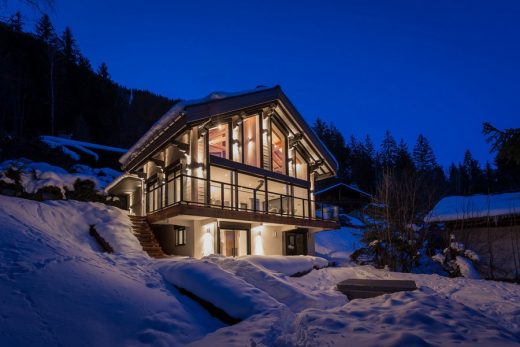
photograph : Alexandre Mermillod Onixstudio.com
Chalet Dag in Chamonix – French Alps Property
Espace Killy Chalet Husky, Val d’Isere, Espace Killy mountain range, French Alps
Design: Jean-Charles Covarel
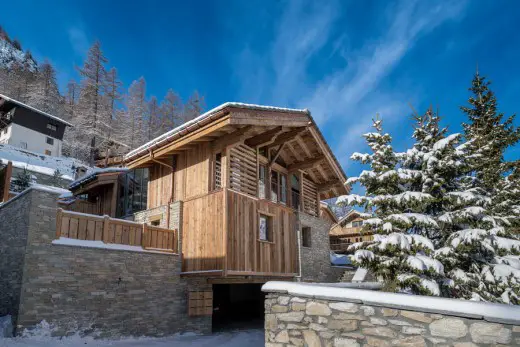
photograph © Athena Advisors
Chalet Husky, Val d’Isere – French Alps Accommodation
Paris Architecture Tours by e-architect
French Architect – design firm listings
Comments / photos for the Q-Park Ravet, Chambéry, France designed by Hérault Arnod page welcome

